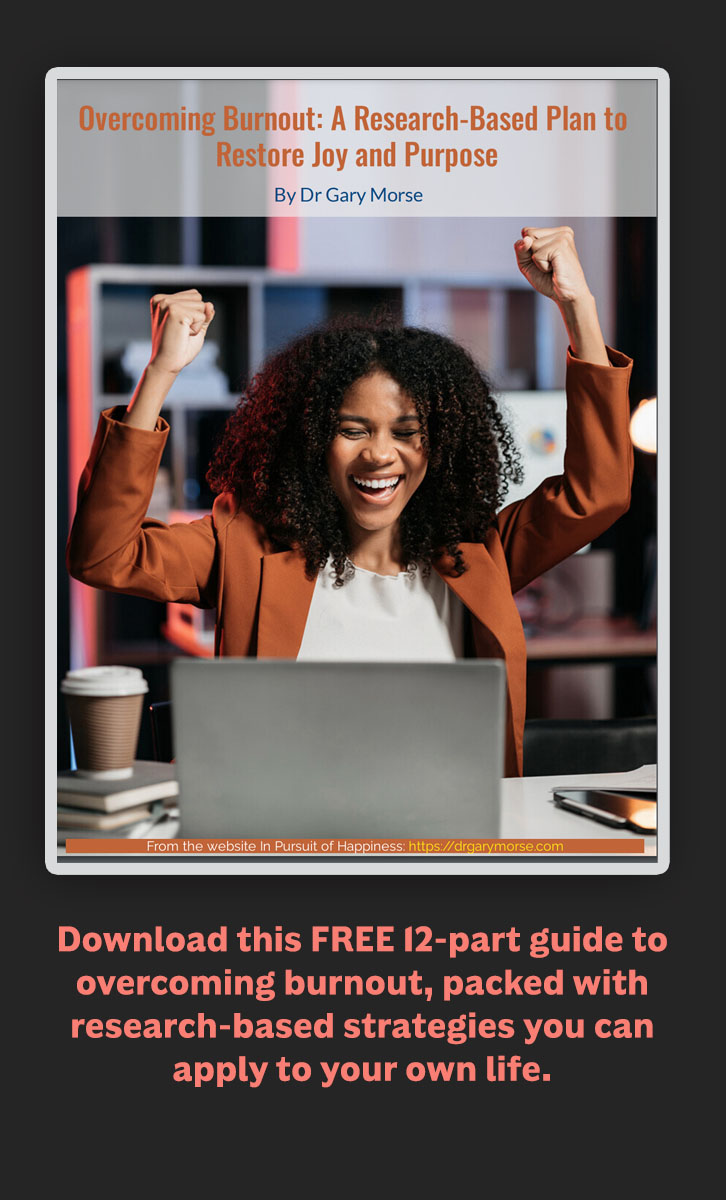Learn in this sixth post in the Overcoming Burnout series how to reclaim your time at work to improve your well-being and fight burnout.
Time is one of our most precious resources.
Although many of us pursue money—something that is certainly important—ultimately, we will have less time than money in life.
Each of us has twenty-four every day, but our personal sense of time varies widely among people. Many people feel harried, always busy, and often lament “I have no time.” These experiences pervade much of life and they are often especially rampant at work.
Feeling overwhelmed and without enough time is a common experience leading up to and signaling burnout. The sense of feeling harried and too busy leads to stress and often a lack of efficiency, productivity, and calmness at work.
Reclaiming your time and having a sense of being in control, instead of overwhelmed, is critical for working well-being, for preventing burnout, and for your own health and well-being.
Being in control of your time is crucial but it is an area that is rife with tension and conflict.
Inevitably, there will be external tugs and pulls on your time. Often there is a conflict between your own goals for your work time and what others—supervisors, coworkers, and clients—want, need, and demand from you.

Image by Gerd Altmann from Pixabay
A foundational key to reclaiming your time is to recognize that some of these demands on you will be important, some necessary, some urgent, and some none of these.
The critical task for each worker is to find an approach—one that is comprehensive but which often requires creativity and skill—that simultaneously:
- Honors the important and necessary needs of others, your job description, and your organization;
- Respects and accommodates your own mission, values, goals, and strengths; and
- Brings you a sense of fulfillment and well-being in your work.
Different jobs allow for varying levels of employee and autonomy over their time. Clearly, some employees have greater latitude, flexibility, and autonomy than others.
Still, nearly all jobs contain some potential for discretion and autonomy, even if in limited amounts. And even small degrees of autonomy can be important for work well-being.
As described in detail in my upcoming book, Finding Purpose in a Burned Out World: How You Can Overcome Burnout, you can use three major strategies to reclaim your time—or at least more of it:
- Set compassionate boundaries and limits around the things (and people) that sap your time, spirit, and meaningful productivity.
- Organize your time by building your schedule around the work activities that are most important and which enable you to provide your greatest contributions while also minimizing time wasters.
- Change the way you approach—and thereby experience—your time.
Given the importance of the time, we will discuss some of these strategies in blog posts.
This first post looks at setting compassionate boundaries and the next post will discuss some of the methods for organizing your schedule.
Additional information on these two approaches, and on changing the way you experience time, are described in the upcoming, Finding Purpose in a Burned Out World: How You Can Overcome Burnout.
Reclaim Your Time by Constructing Compassionate Boundaries
Often burnout results from simply doing too much or from saying yes too often. As a result, we often then feel exhausted, overwhelmed, used up, and empty.
Setting limits is one major strategy we can use to both preserve and recover our energy—and to create time for the activities we need for our own well-being.
Although setting limits is a critical skill, it doesn’t come easily for some of us. Many of us were raised to be compassionate, to serve the needs of others, to be productive, and to achieve.
Being compassionate, productive, and serving the needs of others can all be important values and personal strengths.
However, if taken to the extreme, each of these qualities makes us vulnerable to burnout.
For example, in valuing compassion and service, we sometimes mistakenly think we always need to meet the needs of other people. Although this approach may sound noble, it overlooks two critical facts:
- Each of us has important personal needs and goals that also must be addressed, and
- If we always try to give to others at the expense of our own needs, we will eventually burnout and experience feelings like irritability, resentment, apathy, numbness, and exhaustion—emotional spaces that are not healthy for ourselves or others. Similar consequences can result when a worker becomes obsessed with productivity and accomplishments.
To preserve our capacity for compassion and service—as well as our ability to be productive and healthy—we need, first, to consider, and second at times, to create compassionate boundaries.
Compassionate boundaries mean, at certain times, setting limits on your energy and attention in order to stay healthy for your own good—and consequently then for the good of others, too. Being burned out does not serve you, your clients, customers, employer, or family.

Art by Open Clipart on Pixabay
There are no hard and fast rules about where those boundaries need to be set. We each have our own, varying needs, goals, and capacities. But it is important to realize and set compassionate boundaries in three ways.
Determine Your Boundaries for Work Time
An important first step is deciding your boundaries regarding how much and when you will work.
Work for many people in white collar and service jobs has lost its sense of boundaries. The eight-hour day slides into nine, ten, twelve hours a day on a regular basis for many employees.
The reasons are multiple and include work overload, an inner sense of needing to do more, and difficulties with time management. The ubiquitous presence of technology such as laptop computers and smart phones with their accompanying emails and text messages also adds to longer days, creating what Bill Ivey called “the perpetual work day.”
That is, the bounded work shift, such as from 8:30 to 5, has been transformed to an endless sea of potential work time, such as answering and writing emails at night from home, working on a project on the laptop over the weekend, or even taking care of work while on vacation.
Many of us feel the need to “catch up on emails” every evening at home and this feeling is exacerbated by bosses, coworkers, and entire business cultures that continue to spawn work emails throughout the evening, night, and early morning.
All of this is not to say that you should necessarily limit all of your work activities to your eight-hour shift—though that may be a healthy and wise choice for some. Rather, it is important to consciously decide where your personal limits and boundaries are.
For example, some employees may decide it helps them to stay an extra half-hour twice a week at the end of the day while still at the office to respond to emails or catch up on paperwork. Another employee may choose to take two hours on a weekend at home to finish critical projects.
The boundaries on when, where, and how much we work are personal decisions—and ones you need to decide based on your own self-reflection. For starters, it is important to take a moment to answer this question:
What compassionate boundaries do you need to create around your job to prevent burnout and support your well-being? You can use section A of the worksheet to jot down your responses.
Of course, your personal boundaries affect not just you but other people at your work too.
It is important then to have a conversation about your compassionate boundaries with your supervisor and others, such as your coworkers or clients, affected by your boundaries.
Inform them about both your boundaries and the reasons for it: such as, you are wanting to maximizing your creativity and productivity at work while also preventing burnout and improving your work well-being.
It can also be useful to establish with your supervisor, coworkers, or clients ways that they can reach you during serious, urgent situations.
Boundaries to “Carve In” Important Activities
A second important area is to construct compassionate boundaries to “carve-in” time for the activities you need for your health, renewal, and work-life balance.
For example, you may decide that staying an extra half-hour at the office when necessary is okay as long as you are home each day for 6 p.m. dinner with the family.

Photo by Aubrey Adom on Unsplash
Or another person might create a boundary to ensure that they are at the gym by 5:30 each day for yoga classes or workouts.
Again, we vary in our feelings about what is most important that we want to protect. The crucial question is a personal one:
What boundaries do you need and want to create for your own well-being and work-life balance?
Think about your answers and commit to them in your mind and schedule. You can use Section B of the worksheet to write out your ideas.
Boundaries for How You Spend Your Time
A third important strategy is to construct boundaries around how you spend your time.
In particular, it is important to set boundaries, where possible, around those activities that drain a sense of meaning, fulfillment, and accomplishment at work.
Clearly, some work activities will be required of each of us and are beyond our control. Further, this fact is truer for some employees than others.
Still, nearly every worker has some degree of discretion in their work. And you can capitalize on your ability, where it exists, to set boundaries around some of the activities that cause burnout.
Let’s be more specific.
Common examples are employees who are asked—or volunteer—for committees that are unproductive or beyond the scope of their job duties or what is personally meaningful.
Another example are some meetings that another person wants you to attend, but which are neither mandatory nor productive.
In addition, in most jobs, other workers, including peers, sometimes try to dump “hot potato” tasks on you; often this occurs when they haven’t managed their own time well or thought through the value of the task.
Central to this strategy is the point that Stephen Covey asserted in his classic book, The Seven Habits of Highly Effective People: we need to learn to say “no” to some activities that are less important in order to say “yes” to invest time in those activities that are most meaningful.

Photo by Pete Linforth on Pixabay
This is a critical skill for learning to simplify your work—and your life—to what is most important.
Doing so goes against the grain of some cultural messages that you should do everything you can, but such adages are myths that perpetuate burnout.
Learning to set boundaries and carving out the activities (when you can) that leave you unfulfilled and exhausted are necessary steps in creating more time and energy for what is most important.
In addition, it can boost both your meaningful work productivity and your personal sense of well-being.
Use this worksheet to identify activities that you need to set boundaries around. In particular, think about what activities drain you and take away from more meaningful and productive work activities? Which of these can you say “no” to or minimize?
In passing, it is again worth noting that although our focus is on preventing burnout at work, an experience like burnout is all too common for many individuals across the expanse of their lives.
Working parents and employees caring for their elderly or disabled family members are especially at-risk for feeling overwhelmed and stressed out, and the temptation to try to “do it all” traps many parents.
The practice of setting consistent boundaries is a technique that can be used at home and in families as well as on the job.
Lead graphic by John Hain, Pixabay



Follow Me: